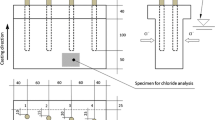Abstract
Corrosion rates of steel rods embedded in concrete specimens similar to those of Part 1 have been determined by linear polarization. For specimens exposed to external sources of chloride the probability of depassivation increased with the chloride: hydroxyl concentration in the pore solution, beyond a threshold ratio of approximately 3. Thereafter corrosion was subject to anodic control. Chlorides introduced as admixtures tended to promote corrosion at somewhat lower chloride: hydroxyl ratios. Rankings of the materials and exposure regimes studied in terms of their corrosion severity have been established, and problems in relating the behaviour of laboratory specimens to that of reinforced concrete structures are considered.
Resume
Cet article est le second d’une étude en deux parties de la corrosion des armatures dans le béton contaminé par des chlorures. La première partie portait sur la caractérisation des profils de concentration du chlorure libre et des ions hydroxyles dans des spécimens de béton exposés à différents régimes de progression de sels. Ici, les vitesses de corrosion des électrodes en acier disposées à différentes profondeurs de la surface exposée de spécimens de béton équivalents à ceux utilisés dans le première partie ont été contrôlées par la méthode de mesure de polarisation en courant continu, dans le but d’établir un rapport entre les modifications en fonction du temps dans la réponse à la corrosion des électrodes et les variations progressives de la composition de la solution intestitielle du béton. Il fut ainsi possible d’élucider les conditions qui engendrent la dépassivation de l’acier dans le béton.
On a découvert que, pour des spécimens du type étudié, l’exposition au chlorure de provenance extérieure entraînait un risque important de dépassivation de l’acier quand la concentration relative chlorure/ions hydroxyles dans la solution interstitielle dépassait un seuil d’environ 3. Il se trouve que la corrosion de l’acier qui en découle dépend du contrôle anodique. Les sels introduits pour contaminer les matériaux du béton tendent à favoriser la corrosion à des concentrations relatives chlorure/ions hydroxyles un peu inférieures.
Les résultats obtenus ont permis de classer les différents régimes d’exposition et les bétons étudiés en fonction du degré de corrosion. on a aussi discuté les problèmes posés par la relation entre le comportement de tels spécimens de laboratoire et celui de structures véritables en béton armé.
Similar content being viewed by others
References
Andrade, C. and Gonzalez, J. A., ‘Quantitative measurements of corrosion rate of reinforcing steels embedded in concrete using polarisation resistance measurements’,Werkst. Korrosion 29 (1978) 515–519.
Gonzalez, J. A., Molina, A., Escudero, M. L. and Andrade, C., ‘Errors in the electrochemical evaluation of very small corrosion rates. 1: Polarisation resistance method applied to corrosion of steel in concrete,’Corros. Sci. 25(10) (1985) 917–930.
John, D. G., Searson, P. C. and Dawson, J. L., ‘Use of AC impedance technique in studies on steel in concrete in immersed conditions,’Br. Corros. J. 16(2) (1981) 102–106.
Gonzalez, J. A., Molina, A., Escudero, M. L. and Andrade, C., ‘Errors in the electrochemical evaluation of very small corrosion rates. 2: Other electrochemical techniques applied to corrosion of steel in concrete,’Corros. Sci. 25(7) (1985) 519–539.
Dawson, J. L., ‘Corrosion monitoring of steel in concrete,’ in ‘Corrosion of Reinforcement in Concrete Construction’, edited by A. P. Crane (Ellis Horwood, Chichester, 1983) pp. 175–191.
Hardon, R. G., Lambert, P. and Page, C. L., ‘Relationship between electrochemical noise and corrosion rate of steel in salt contaminated concrete’,Br. Corros. J. 23(4) (1988) 225–228.
Newton, C. J. and Sykes, J. M., ‘A galvanostatic pulse technique for investigation of steel corrosion in concrete’,Corros. Sci. 28(11) (1988) 1051–1074.
Page, C. L. and Lambert, P., ‘Analystical and electrochemical investigations of reinforcement corrosion’, TRRL Contractor Report CR30 (Transport and Road Research Laboratory, Crowthorne, UK, 1986).
Page, C. L., Lambert, P. and Vassie, P. R. W., ‘Investigations of reinforcement corrosion. 1. The pore electrolyte phase in chloride-contaminated concrete’,Mater. Struct. 24(142) (1991) 243–252.
Lambert, P., ‘Corrosion and passivation of steel in concrete’, PhD thesis, Aston University (1983) pp. 152–153.
Page, C. L. and Havdahl, J., ‘Electrochemical monitoring of corrosion of steel in microsilica cement pastes’,Mater. Struct. 18(91) (1985) 41–47.
Stern, M. and Geary, A. L., ‘Electrochemical polarisation. 1: A theoretical analysis of the shape of polarisation curves’,J. Electrochem. Soc. 104 (1957) 56–63.
Stern, M. and Weisert, E. D., ‘Experimental observations on the relation between polarisation resistance and corrosion rate’,Proc. Amer. Soc. Testing Mater. 59 (1959) 1280–1291.
Shrier, L. L. (ed.), ‘Corrosion. Vol. II: Corrosion Control’ (Newnes-Butterworth, London, 1976) pp. 106–108.
Hausmann, D. A., ‘Steel corrosion in concrete’,Mater. Protection 6 (November 1967) 19–23.
Mangat, P. S. and Gurusamy, K., ‘Corrosion resistance of steel fibres in concrete under marine exposure’,Cement Concr. Res. 18(1) (1988) 44–54.
Vassie, P. R. W., ‘Reinforcement corrosion and the durability of concrete bridges’,Proc. Inst. Civil Engnrs Part 1 76 (1984) 713–723.
Page, C. L., ‘Mechanism of corrosion protection in reinforced concrete marine structures’,Nature 258(5535) (1975) 514–515.
Page, C. L. and Treadaway, K. W. J., ‘Aspects of the electrochemistry of steel in concrete’,ibid. 297(2862) (1982) 109–115.
Treadaway, K. W. J., Cox, R. N. and Brown, B. L., ‘Durability of corrosion resisting steels in concrete,’Proc. Inst. Civil Engnrs Part 1,86 (1989) 305–332.
Author information
Authors and Affiliations
Additional information
Crown copyright. The views expressed in this paper are not necessarily those of the Department of Transport.
Rights and permissions
About this article
Cite this article
Lambert, P., Page, C.L. & Vassie, P.R.W. Investigations of reinforcement corrosion. 2. Electrochemical monitoring of steel in chloride-contaminated concrete. Materials and Structures 24, 351–358 (1991). https://doi.org/10.1007/BF02472068
Issue Date:
DOI: https://doi.org/10.1007/BF02472068




